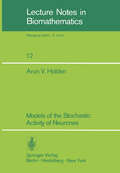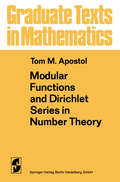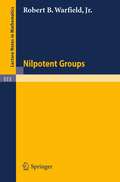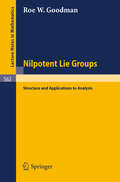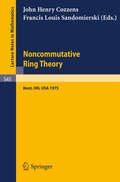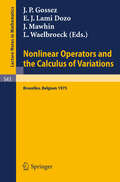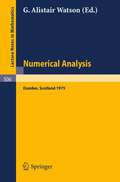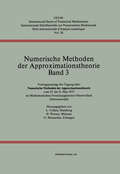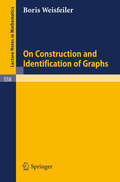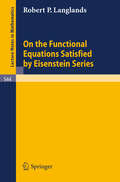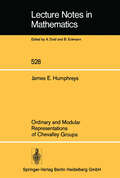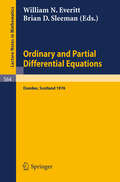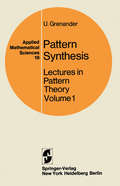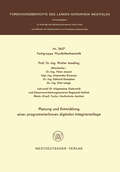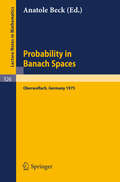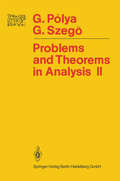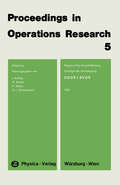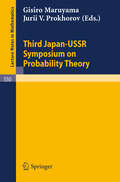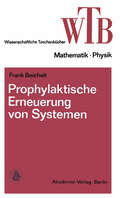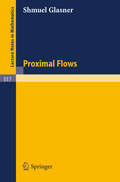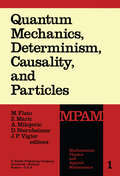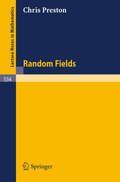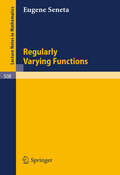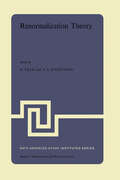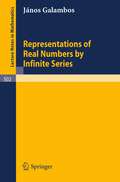- Table View
- List View
Models of the Stochastic Activity of Neurones (Lecture Notes in Biomathematics #12)
by A. V. HoldenThese notes have grown from a series of seminars given at Leeds between 1972 and 1975. They represent an attempt to gather together the different kinds of model which have been proposed to account for the stochastic activity of neurones, and to provide an introduction to this area of mathematical biology. A striking feature of the electrical activity of the nervous system is that it appears stochastic: this is apparent at all levels of recording, ranging from intracellular recordings to the electroencephalogram. The chapters start with fluctuations in membrane potential, proceed through single unit and synaptic activity and end with the behaviour of large aggregates of neurones: L have chgaen this seque~~e\/~~';uggest that the interesting behaviourr~f :the nervous system - its individuality, variability and dynamic forms - may in part result from the stochastic behaviour of its components. I would like to thank Dr. Julio Rubio for reading and commenting on the drafts, Mrs. Doris Beighton for producing the final typescript and Mr. Peter Hargreaves for preparing the figures.
Modular Functions and Dirichlet Series in Number Theory (Graduate Texts in Mathematics #41)
by Tom M. ApostolThis is the second volume of a 2-volume textbook* which evolved from a course (Mathematics 160) offered at the California Institute of Technology du ring the last 25 years. The second volume presupposes a background in number theory com parable to that provided in the first volume, together with a knowledge of the basic concepts of complex analysis. Most of the present volume is devoted to elliptic functions and modular functions with some of their number-theoretic applications. Among the major topics treated are Rademacher's convergent series for the partition function, Lehner's congruences for the Fourier coefficients of the modular functionj( r), and Hecke's theory of entire forms with multiplicative Fourier coefficients. The last chapter gives an account of Bohr's theory of equivalence of general Dirichlet series. Both volumes of this work emphasize classical aspects of a subject wh ich in recent years has undergone a great deal of modern development. It is hoped that these volumes will help the nonspecialist become acquainted with an important and fascinating part of mathematics and, at the same time, will provide some of the background that belongs to the repertory of every specialist in the field. This volume, like the first, is dedicated to the students who have taken this course and have gone on to make notable contributions to number theory and other parts of mathematics. T. M. A. January, 1976 * The first volume is in the Springer-Verlag series Undergraduate Texts in Mathematics under the title Introduction to Analytic Number Theory.
Nilpotent Lie Groups: Structure and Applications to Analysis (Lecture Notes in Mathematics #562)
by Roe W. GoodmanNoncommutative Ring Theory: Papers Presented at the Internation Conference held at Kent State University April 4-5, 1975 (Lecture Notes in Mathematics #545)
by J. H. Cozzens F. L. SandomierskiNonlinear Operators and the Calculus of Variations: Summer School Held in Bruxelles, 8- 9 September 1975 (Lecture Notes in Mathematics #543)
by J. P. Gossez E. J. Lami Dozo J. Mawhin L. WaelbroeckNumerical Analysis: Proceedings of the Dundee Conference on Numerical Analysis, 1975 (Lecture Notes in Mathematics #506)
by G. A. WatsonNumerische Methoden der Approximationstheorie/Numerical Methods of Approximation Theory: Vortragsauszüge der Tagung über numerische Methoden der Approximationstheorie vom 25. bis 31. Mai 1975 im Mathematischen Forschungsinstitut Oberwolfach (Schwarzwald) (International Series of Numerical Mathematics #30)
by Meinardus Collatz WernerOn the Functional Equations Satisfied by Eisenstein Series (Lecture Notes in Mathematics #544)
by Robert P. LanglandsOrdinary and Modular Representations of Chevalley Groups (Lecture Notes in Mathematics #528)
by J. E. HumphreysOrdinary and Partial Differential Equations: Proceedings of the Fourth Conference held at Dundee, Scotland, March 30 - April 2, 1976 (Lecture Notes in Mathematics #564)
by W. M. Everitt B. D. SleemanPlanung und Entwicklung einer programmierbaren digitalen Integrieranlage (Forschungsberichte des Landes Nordrhein-Westfalen #2607)
by Walter AmelingProbability in Banach Spaces: Proceedings of the First International Conference on Probability in Banach Spaces, 20 - 26 July 1975, Oberwolfach (Lecture Notes in Mathematics #526)
by Anatole BeckProblems and Theorems in Analysis: Theory of Functions · Zeros · Polynomials Determinants · Number Theory · Geometry (Springer Study Edition)
by Georg Polya Gabor SzegöProceedings in Operations Research 5 (Operations Research Proceedings #1975)
by J. Kohlas O. Seifert P. Stähly H. J. ZimmermannProceedings of the Third Japan-USSR Symposium on Probability Theory (Lecture Notes in Mathematics #550)
by G. Maruyama J. V. ProkhorovProphylaktische Erneuerung von Systemen: Einführung in mathematische Grundlagen (Wissenschaftliche Taschenbücher #153)
by Frank BeicheltQuantum Mechanics, Determinism, Causality, and Particles: An International Collection of Contributions in Honor of Louis de Broglie on the Occasion of the Jubilee of His Celebrated Thesis (Mathematical Physics and Applied Mathematics #1)
by M. Flato Z. Maric A. Milojevic Daniel Sternheimer J. P. VigierTwo important events in the history of physical sciences occurred re cently: the fiftieth anniversary of Quantum Mechanics and the Jubilee of Louis de Broglie's celebrated Thesis. These events occurred in the same period of time when the world honored de Broglie on the occa sion of his eightieth birthday. Some of de Broglie's friends, former students, and some people who used to know him and appreciate his personality decided to prepare an international volume for this cele brated occasion. Such a task was not very easy. It is always simpler to contribute in honor of famous people whose works and impact were great on a tech nical and pragmatic level than to contribute in honor of a person whose achievements were not only dominant in physical sciences themselves, but also had many important implications for the development of the whole branch of philosophy of sciences. Louis de Broglie, the man to whom we owe among other things the most fundamental notion of duality between waves and particles, be longs in a way to the Einsteinian school of thought. He never accepted literally the Copenhagen interpretation of quantum mechanics. To him it was clear that this interpretation makes quantum mechanics incomplete and highly non-deterministic. He always believed that since the duality between waves and particles was an experimental fact, there should be some manifestation of the Schrodinger wave itself in the realistic world. De Broglie had to struggle much for this idea, which he never gave up.
Renormalization Theory: Proceedings of the NATO Advanced Study Institute held at the International School of Mathematical Physics at the ‘Ettore Majorana’ Centre for Scientific Culture in Erice (Sicily) Italy, 17–31 August, 1975 (Nato Science Series C: #23)
by A. S. Wightman G. P. VeloThe present volume collects lecture notes from the session of the International School of Mathematical Physics 'Ettore Majorana' on Renormalization Theory that took place in Erice (Sicily), August 17 to August 31, 1975. The School was a NATO Advanced Study Institute sponsored by the Italian Ministry of Public Education, the Italian Minis try of Scientific and Technological Research, and the Regional Sicilian Government. Renormalization theory has, by now, acquired forty years of history. The present volume assumes a general acquaintance with the elementary facts of the subject as they might appear in an introductory course in quantum field theory. For more recent significant developments it provides a systematic intro duction as well as a detailed discussion of the existing state of knowledge. In particular analytic and dimensional renorma lization, normal product technique, and the Bogoliubov-Shirkov Epstein-Glaser method are treated, with applications to physically important gauge theories. All the preceding deals with perturbative renormalization theory. In recent years there has been an interesting development of non-perturbative renormalization theory in models in space-times of two and three dimensions, with the use of the methods of constructive field theory. Despite the simplicity of these models, the results are of significance because they are exact and answer a number of questions of principle. There are parts of renormalization theory which are not well understood, for instance the renormalization theory of non-renormalizable interactions.
